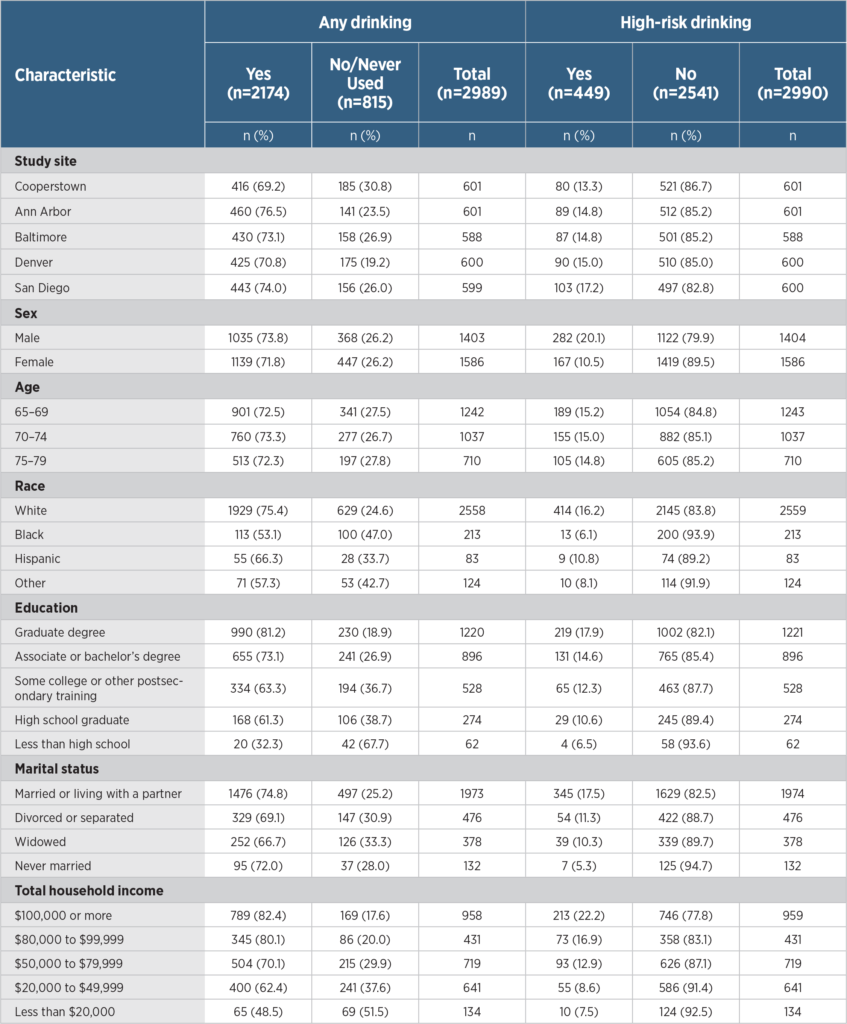
Patterns of Self-Reported Driving While Intoxicated Among Older Adults: AAA LongROAD Study
This research brief examines the prevalence of self-reported alcohol use and alcohol use while driving as well as sociodemographic, health and behavioral factors associated with alcohol use while driving.
April 2019
Suggested Citation
For media inquiries, contact:
Tamra Johnson
202-942-2079
TRJohnson@national.aaa.com
Abstract
This research brief examines the prevalence of self-reported alcohol use and alcohol use while driving as well as sociodemographic, health and behavioral factors associated with alcohol use while driving.
Introduction
Drinking and driving continues to be a major public health problem. The relationship between driving while intoxicated (DWI) and crashes is well-established, with DWI responsible for 28% of today’s crash deaths (NHTSA, 2017). Older adults form a significant proportion of the population of drivers who drink and drive. Indeed, the Substance Abuse and Mental Health Services Administration’s (SAMHSA) National Survey on Drug Use and Health (NSDUH) found that 4% of adults age 65 years and older reported driving under the influence of alcohol in the past year (Lipari, Hughes, & Bose, 2016). The risks of alcohol use in older drivers are exacerbated by delayed alcohol metabolism, increased use of medications, and declining physical and cognitive functioning. Using baseline data from the AAA LongROAD study, we document the prevalence of self-reported alcohol use and alcohol use while driving as well as sociodemographic, health and behavioral factors associated with alcohol use while driving.
Key Findings
- 15% of participants reported high-risk drinking in the previous three months
- 7% of participants reported drinking in the previous three months
- 3% of respondents reported having driven while over the legal limit at least occasionally
Methodology
This study uses baseline data from the longitudinal, multisite AAA LongROAD study, described in detail elsewhere (Li et al., 2017). The AAA LongROAD study aims to explore the role of medical, behavioral, social, technological and environmental factors in safe driving among older adults. The study enrolled 2,990 older drivers at five study sites (Ann Arbor, Michigan; Baltimore, Maryland; Cooperstown, New York; Denver, Colorado; and San Diego, California). AAA LongROAD collects self-reported and objectively measured information on health, functional performance and driving behaviors; objective driving data (from a device that collects location data, accelerometer measurements, etc.); medical record information; medication history; and state motor vehicle driving records.
At participant enrollment, AAA LongROAD participants completed a questionnaire asking about their alcohol use in the last three months and how often they drive when they may be over the legal blood-alcohol limit (i.e. DWI). In addition, they were asked about their average weekly alcohol intake. For the purpose of this study, we defined high-risk drinking as more than seven drinks per week regardless of gender, according to current National Institute on Alcohol Abuse and Alcoholism (NIAAA) guidelines for older adults (NIAAA, accessed 2018), and we compared subjects who reported “never” or “hardly ever” driving under the influence with those reporting DWI “occasionally” or more often.
After a bivariate analysis of the relationship between sociodemographic, health, and driving-related variables and DWI behavior was conducted, a logistic regression model was constructed to identify the factors most strongly associated with DWI among the study population. In addition to high-risk drinking behavior, driving frequency and demographic information, including study site, gender, age, race, marital status, education level and income were used to construct the model. Additional variables were included in the derivation of the final model if they achieved an alpha level of less than 0.25 on bivariate analysis.
Results
The majority of participants (72.7%) reported drinking (“any drinking”) in the last three months. 15% of respondents reported high-risk drinking, and 3.3% of respondents reported having driven while over the legal limit at least occasionally.
Based on the results of bivariate analyses of the factors associated with self-reported DWI, anger and emotional support met the threshold for inclusion for construction of the final logistic regression model (p<0.25), as did reported avoidance of hazardous driving conditions and distracted driving, self-rated physical readiness for driving, level of comfort during driving and risky driving behaviors. Demographic information, number of days and miles driven in a normal week, and high-risk drinking practices were adjusted for in the final model.
High-risk drinking was found to be significantly associated with driving over the limit at least occasionally (adjusted OR=12.01, 95% CI: 7.19, 20.07). Reporting risky driving behaviors was also significantly associated with driving while intoxicated at least occasionally (adjusted OR=13.34, 95% CI: 6.02, 29.56), while reporting avoidance of hazardous driving conditions was less likely to be associated with doing so (adjusted OR=0.71, 95% CI: 0.60, 0.85) as was higher level of comfort during challenging driving scenarios (adjusted OR=0.65, 95% CI: 0.44, 0.95). Finally, participants in the Denver study site were less likely to have driven while intoxicated at least occasionally (adjusted OR=0.40, 95% CI: 0.16, 0.98), while female gender was also less likely to be associated with driving while intoxicated at least occasionally (adjusted OR=0.47, 95% CI: 0.26, 0.83).
Suggested Citation
For media inquiries, contact:
Tamra Johnson
202-942-2079
TRJohnson@national.aaa.com
